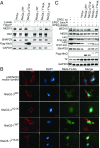Functional diversification of the NleG effector family in enterohemorrhagic Escherichia coli
- PMID: 30217892
- PMCID: PMC6176568
- DOI: 10.1073/pnas.1718350115
Functional diversification of the NleG effector family in enterohemorrhagic Escherichia coli
Abstract
The pathogenic strategy of Escherichia coli and many other gram-negative pathogens relies on the translocation of a specific set of proteins, called effectors, into the eukaryotic host cell during infection. These effectors act in concert to modulate host cell processes in favor of the invading pathogen. Injected by the type III secretion system (T3SS), the effector arsenal of enterohemorrhagic E. coli (EHEC) O157:H7 features at least eight individual NleG effectors, which are also found across diverse attaching and effacing pathogens. NleG effectors share a conserved C-terminal U-box E3 ubiquitin ligase domain that engages with host ubiquitination machinery. However, their specific functions and ubiquitination targets have remained uncharacterized. Here, we identify host proteins targeted for ubiquitination-mediated degradation by two EHEC NleG family members, NleG5-1 and NleG2-3. NleG5-1 localizes to the host cell nucleus and targets the MED15 subunit of the Mediator complex, while NleG2-3 resides in the host cytosol and triggers degradation of Hexokinase-2 and SNAP29. Our structural studies of NleG5-1 reveal a distinct N-terminal α/β domain that is responsible for interacting with host protein targets. The core of this domain is conserved across the NleG family, suggesting this domain is present in functionally distinct NleG effectors, which evolved diversified surface residues to interact with specific host proteins. This is a demonstration of the functional diversification and the range of host proteins targeted by the most expanded effector family in the pathogenic arsenal of E. coli.
Keywords: Escherichia coli; effectors; pathogenesis; ubiquitination.
Conflict of interest statement
The authors declare no conflict of interest.
Figures



Similar articles
-
Distinct Molecular Features of NleG Type 3 Secreted Effectors Allow for Different Roles during Citrobacter rodentium Infection in Mice.Infect Immun. 2023 Jan 24;91(1):e0050522. doi: 10.1128/iai.00505-22. Epub 2022 Dec 13. Infect Immun. 2023. PMID: 36511702 Free PMC article.
-
NleG Type 3 effectors from enterohaemorrhagic Escherichia coli are U-Box E3 ubiquitin ligases.PLoS Pathog. 2010 Jun 24;6(6):e1000960. doi: 10.1371/journal.ppat.1000960. PLoS Pathog. 2010. PMID: 20585566 Free PMC article.
-
An extensive repertoire of type III secretion effectors in Escherichia coli O157 and the role of lambdoid phages in their dissemination.Proc Natl Acad Sci U S A. 2006 Oct 3;103(40):14941-6. doi: 10.1073/pnas.0604891103. Epub 2006 Sep 21. Proc Natl Acad Sci U S A. 2006. PMID: 16990433 Free PMC article.
-
Cooperative Immune Suppression by Escherichia coli and Shigella Effector Proteins.Infect Immun. 2018 Mar 22;86(4):e00560-17. doi: 10.1128/IAI.00560-17. Print 2018 Apr. Infect Immun. 2018. PMID: 29339461 Free PMC article. Review.
-
[Mechanism of A/E lesion formation produced by enterohemorrhagic Escherichia coli: O157--role of EspB, Tir and cortactin].Nihon Rinsho. 2002 Jun;60(6):1101-7. Nihon Rinsho. 2002. PMID: 12078080 Review. Japanese.
Cited by
-
Bacterial Factors Targeting the Nucleus: The Growing Family of Nucleomodulins.Toxins (Basel). 2020 Mar 31;12(4):220. doi: 10.3390/toxins12040220. Toxins (Basel). 2020. PMID: 32244550 Free PMC article. Review.
-
Conservation lost: host-pathogen battles drive diversification and expansion of gene families.FEBS J. 2021 Sep;288(18):5289-5299. doi: 10.1111/febs.15627. Epub 2020 Dec 2. FEBS J. 2021. PMID: 33190369 Free PMC article. Review.
-
The S. Typhi effector StoD is an E3/E4 ubiquitin ligase which binds K48- and K63-linked diubiquitin.Life Sci Alliance. 2019 May 29;2(3):e201800272. doi: 10.26508/lsa.201800272. Print 2019 Jun. Life Sci Alliance. 2019. PMID: 31142637 Free PMC article.
-
Distinct Molecular Features of NleG Type 3 Secreted Effectors Allow for Different Roles during Citrobacter rodentium Infection in Mice.Infect Immun. 2023 Jan 24;91(1):e0050522. doi: 10.1128/iai.00505-22. Epub 2022 Dec 13. Infect Immun. 2023. PMID: 36511702 Free PMC article.
-
An acetyltransferase effector conserved across Legionella species targets the eukaryotic eIF3 complex to modulate protein translation.mBio. 2024 Mar 13;15(3):e0322123. doi: 10.1128/mbio.03221-23. Epub 2024 Feb 9. mBio. 2024. PMID: 38335095 Free PMC article.
References
-
- Kaper JB, Nataro JP, Mobley HL. Pathogenic Escherichia coli. Nat Rev Microbiol. 2004;2:123–140. - PubMed
-
- Caprioli A, Morabito S, Brugère H, Oswald E. Enterohaemorrhagic Escherichia coli: Emerging issues on virulence and modes of transmission. Vet Res. 2005;36:289–311. - PubMed
-
- Ashida H, Kim M, Sasakawa C. Exploitation of the host ubiquitin system by human bacterial pathogens. Nat Rev Microbiol. 2014;12:399–413. - PubMed
Publication types
MeSH terms
Substances
Associated data
- Actions
- Actions
Grants and funding
LinkOut - more resources
Full Text Sources
Other Literature Sources
Medical

